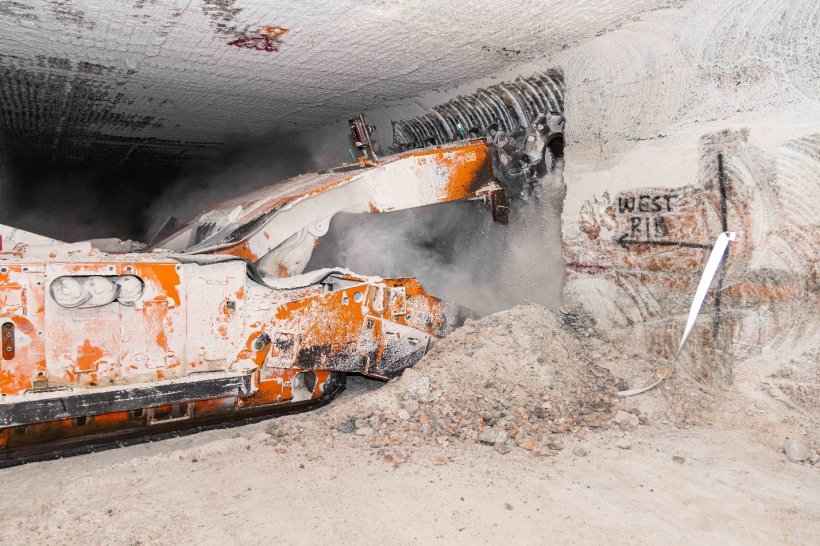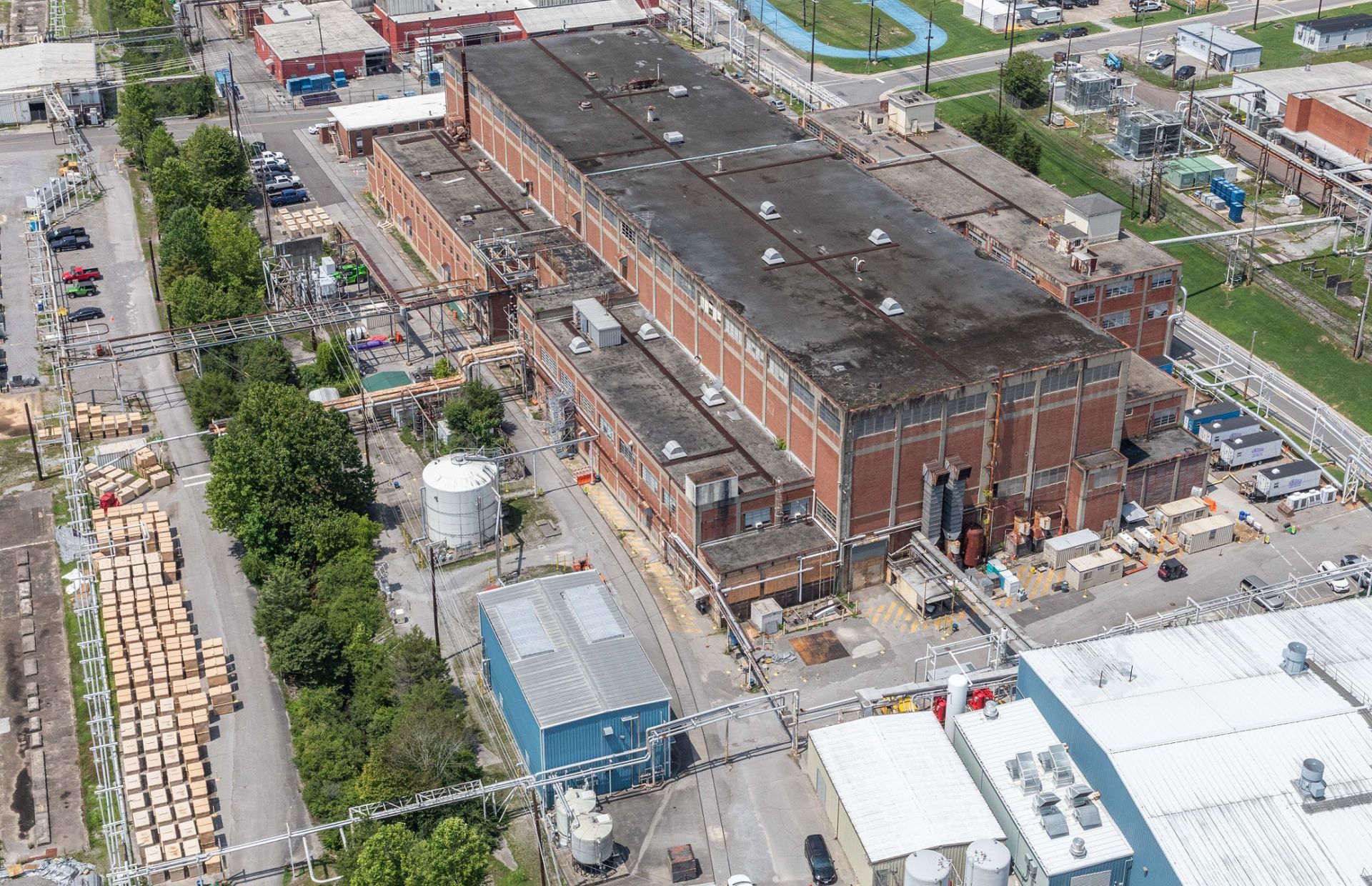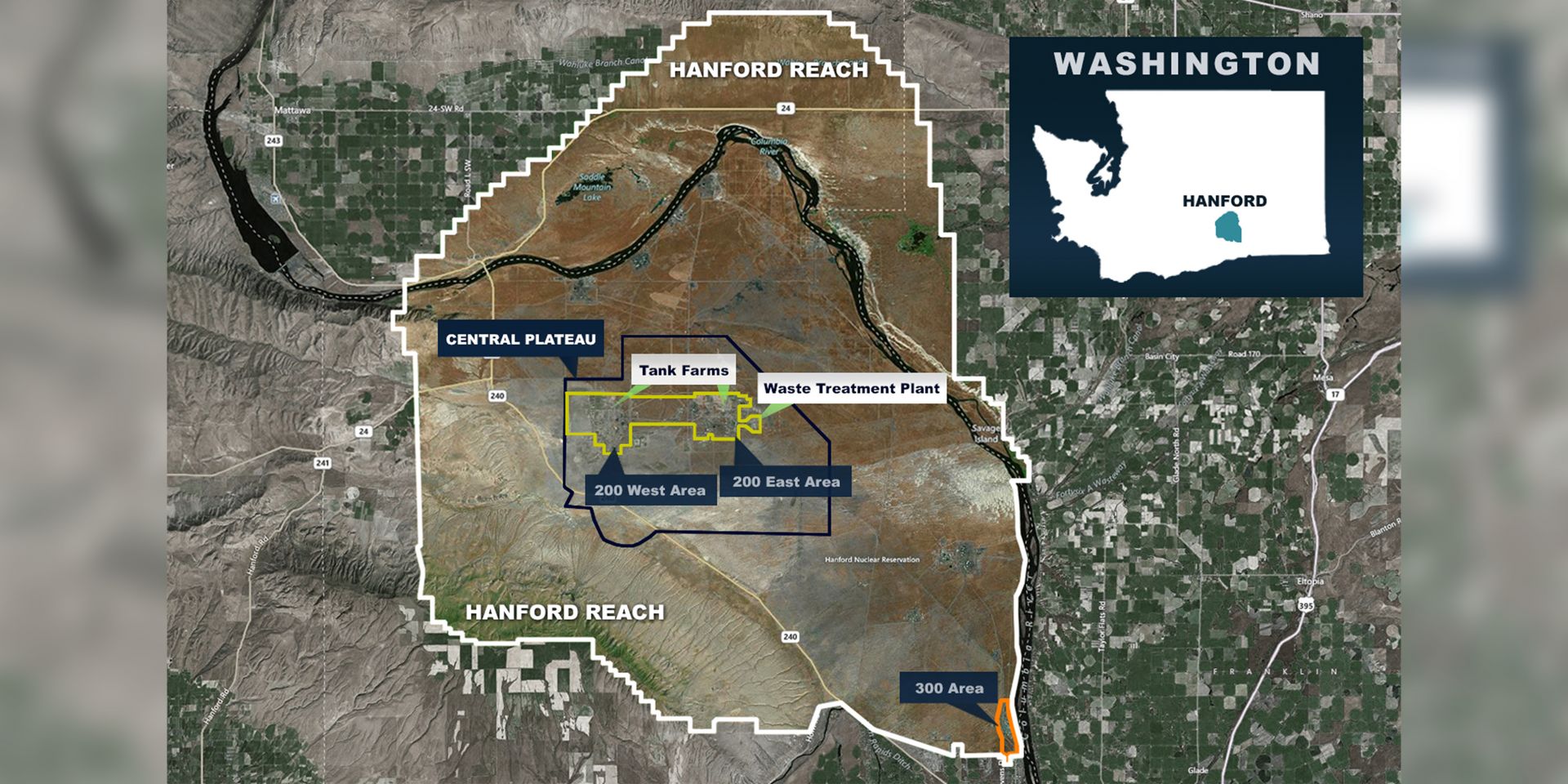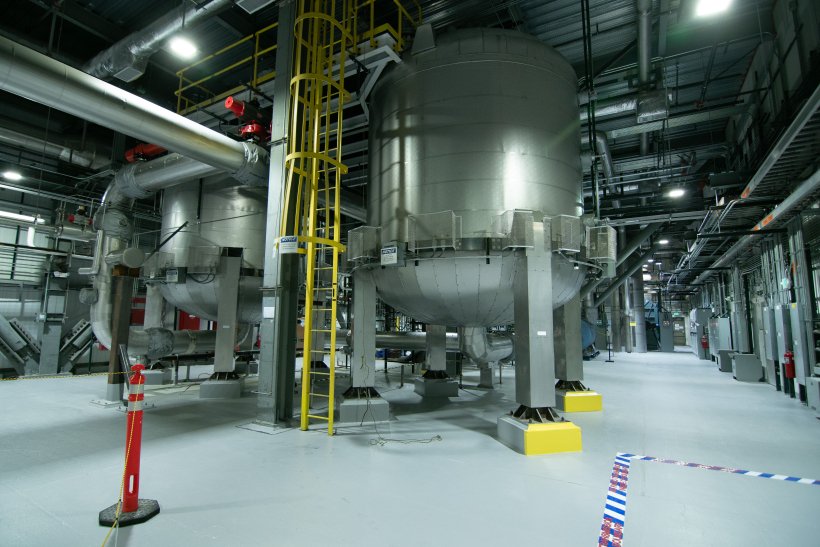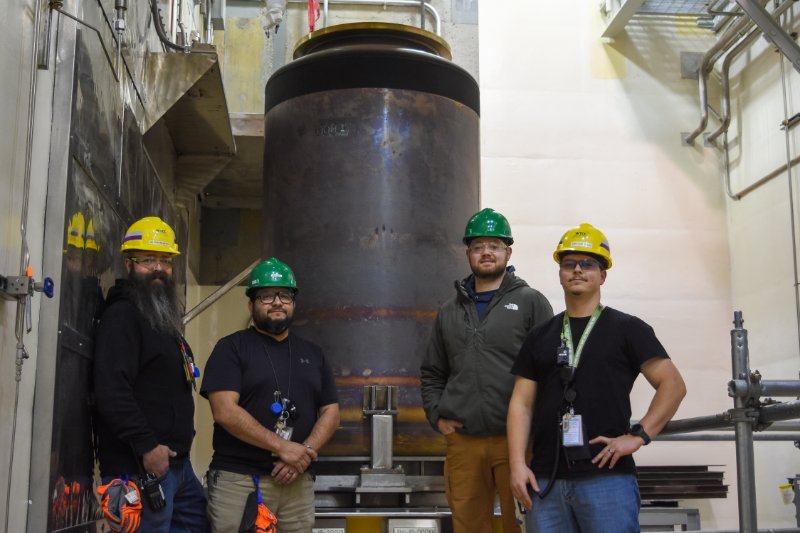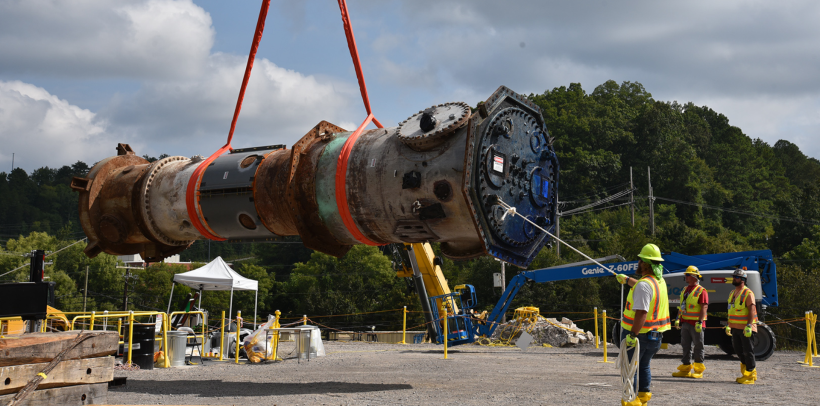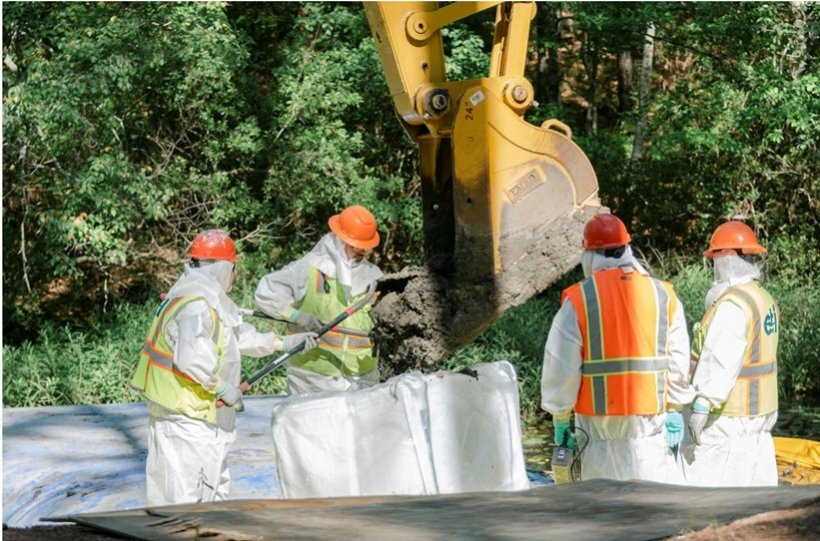A continuous miner machine cuts into salt rock as mining begins on Panel 11, one of WIPP’s next waste disposal panels. (Photo: DOE)
For the first time in a decade, crews have started mining a new disposal panel at the Department of Energy’s Waste Isolation Pilot Plant (WIPP) in New Mexico, the nation’s deep geologic waste repository for defense-related transuranic waste.
Oak Ridge crews will begin demolition of the 325,000-sqaure-foot Alpha-2 facility this year, marking the first teardown of a former uranium enrichment facility at Y-12. (Photo: DOE)
The Department of Energy announced that its Oak Ridge Office of Environmental Management (OREM) is moving ahead with a slate of projects this year that will alter the Tennessee site’s skyline, remove inventories of nuclear waste, and complete a major phase of cleanup.
The DOE’s Hanford Site. (Image: Washington River Protection Solutions)
The Department of Energy’s Office of Environmental Management issued for public comment the first request for qualifications (RFQ) related to the department’s Cleanup to Clean Energy initiative, which aims to increase energy production by making DOE land available for the potential development of carbon-free energy (CFE) electricity generation through leases.
A view of two vessels that each contain approximately 30,000 pounds of granulated activated carbon, used to remove mercury from process off-gas during IWTU operations. (Photo: DOE)
The Department of Energy’s Office of Environmental Management said Idaho’s Integrated Waste Treatment Unit (IWTU) is set to resume radioactive liquid waste treatment operations early next year after crews replaced carbon material from two plant vessels. The IWTU was shut down for an unplanned outage on September 6 to address elevated mercury concentrations in the plant’s granulated activated carbon (GAC) beds, according to Defense Nuclear Facilities Safety Board (DNFSB) reports.
Crewmembers stand in front of the first stainless-steel container filled with molten test glass at Hanford’s Vit Plant. (Photo: Bechtel National)
Bechtel and the Department of Energy’s Office of Environmental Management announced on December 4 that the first set of test glass was successfully poured into a stainless-steel storage container designed to hold vitrified waste at Hanford’s Waste Treatment and Immobilization Plant, also known as the Vit Plant.
DOE and NNSA personnel at a meeting discussing the plans for the upcoming SRS landlord transition. (Photo: DOE)
Personnel from the Department of Energy’s Office of Environmental Management and the National Nuclear Security Administration recently gathered to discuss plans for the upcoming transfer of landlord responsibility for the Savannah River Site in South Carolina.
Electrical circuits are tested during the commissioning of the new ventilation system at WIPP. (Photo: DOE)
Commissioning has begun on a new large-scale ventilation system at the Waste Isolation Pilot Plant in New Mexico.
The Safety Significant Confinement Ventilation System (SSCVS) is expected to increase underground airflow from 170,000 cubic feet per minute up to 540,000 cfm. The increased airflow will allow for simultaneous underground waste emplacement, mining, and ground control work. Ground control, including bolting, controls the movement of salt rock—known as salt creep—in the WIPP underground.
Workers monitor the pouring of melter glass from a control room in Hanford’s LAW Facility. (Photo: DOE)
The Department of Energy’s Office of Environmental Management said crews at its Hanford Site in Washington state have started pouring the first molten glass from a waste vitrification melter into a stainless steel container at the site’s Waste Treatment and Immobilization Plant, also known as the Vit Plant.
Crews demolish one of two massive steam condensers at the Naval Reactors Facility’s A1W prototype reactor facility in Idaho. Click photo to enlarge (Photo: DOE)
The Department of Energy’s Office of Environmental Management said that crews at the Idaho National Laboratory site are making “significant progress” decommissioning the Submarine 1st Generation Westinghouse (S1W) reactor, the prototype pressurized water reactor that supported the development of the USS Nautilus, the world’s first operational nuclear-powered submarine.
Contaminated soil is loaded in containers for disposal at the Oak Ridge Reservation in Tennessee. (Photo: DOE)
The Department of Energy’s Office of Environmental Management said a new regulatory partnership framework established in recent years by the Oak Ridge Office of Environmental Management (OREM), its contractor United Cleanup Oak Ridge (UCOR), the Environmental Protection Agency, and the Tennessee Department of Environment and Conservation (TDEC) is ushering in a new chapter of accelerated cleanup at the department’s Oak Ridge Reservation in Tennessee.
The Low Intensity Test Reactor structure is lifted from its housing and placed in a specialized carbon metal container for shipment for disposal. (Photo: DOE)
The Department of Energy’s Office of Environmental Management announced it has completed a second of its 2023 priorities at Oak Ridge in as many months with the demolition of the Low Intensity Test Reactor, known as Building 3005, at the Tennessee site.
Watch a video of Building 3005 and its decommissioning here.
Workers remove contaminated sediment from the SRS in South Carolina. A $19 million DOE grant will support state monitoring of the site. (Photo: DOE)
The Department of Energy’s Office of Environmental Management has awarded nearly $54 million in noncompetitive financial assistance grants and cooperative agreements to help support the office’s cleanup program. DOE-EM is responsible for environmental legacy cleanup of the effects of decades of nuclear weapons development and government-sponsored nuclear energy research.
A West Valley ancillary support building is demolished in 2018. (Photo: DOE/CH2M Hill–BWXT West Valley)
The Department of Energy’s Office of Environmental Management has issued a draft request for proposal for a contract covering the next phase of cleanup at the West Valley Demonstration Project in western New York.
An elk herd at the DOE’s Hanford Site in Washington state. (Photo: DOE)
The Department of Energy has released the first request for information (RFI) related to the department’s Cleanup to Clean Energy initiative, which aims to repurpose certain DOE-owned lands, portions of which were previously used in the nation’s nuclear weapons program, into sites for clean energy generation.
The DOE-EM–Sandia team and Sellafield representatives pose with Spot Robot at the Sellafield Engineering and Maintenance Centre of Excellence. (Photo: DOE)
Robotics experts from Sandia National Laboratories and representatives from the Department of Energy Office of Environmental Management’s Technology Development Office recently visited the Sellafield nuclear site in England to discuss how robotics, artificial intelligence, and other emerging tools can be developed and used in nuclear cleanup operations.
The Alpha-2 building at Y-12 in Oak Ridge is a former uranium enrichment facility that dates to the Manhattan Project era. (Photo: DOE)
The Department of Energy’s Office of Environmental Management said that crews have completed major deactivation efforts at the Alpha-2 building at the Y-12 National Security Complex in Oak Ridge, Tenn. The former uranium enrichment facility is scheduled for demolition next year.
